Keyword
Earth Science | Biological Classification | Bacteria/Archaea
81 record(s)
Type of resources
Topics
Keywords
Contact for the resource
Provided by
Formats
Representation types
Update frequencies
Status
draft
-
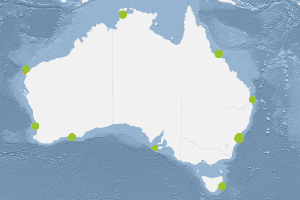
This dataset comprises the phytoplankton abundance and biovolume estimates as part of a broader sampling program carried out at the Southern Ocean Time Series, a facility within the Integrated Marine Observing System (IMOS). The primary focus is sustained observing of ocean properties and processes important to climate, carbon cycling, and ocean productivity. Regular phytoplankton samples are collected at approximately 14 day intervals (exact intervals and seasonal coverage dependent on deployment length). The moorings are serviced annually, at which time the existing moorings are recovered and new moorings are deployed. Water samples from within the surface mixed-layer are collected at pre-programmed intervals using a Remote Access Sampler, in pairs about 1 hour apart. One sample in each pair is preserved for phytoplankton community composition by microscopy, and the other sample is preserved and used for accompanying chemical analysis of nutrients, total dissolved inorganic carbon (DIC) and alkalinity. Each sample is collected from within the surface mixed-layer at 32 m depth (2010 - 2017) or 5 m depth (2018-current) depending on the design of the mooring surface assembly and instrumentation. Typically a maximum of 24 samples are collected over an annual deployment cycle. The samples collected are analysed for: 1. Community composition / abundance (cells/L) 2. calculated biovolume (um3/L). Protocols for the phytoplankton time-series are described in Eriksen et al (2018), and the annual sample reports for each deployment. Data storage and access is planned to be interoperable with other national and international programs through the IMOS Infrastructure. Station metadata can be found through this resource. Data is available freely via the AODN portal: https://portal.aodn.org.au. As the taxonomic resolution of the data has changed over time, due to continual training, it is important that users refer to the change log tables included in your data download. These will provide information on the validity of the taxa, from what date we have been identifying certain taxa etc. Classification fields may be blank depending on the level to which that taxa has been identified, i.e. if only identified to family, genus and species will be blank.
-
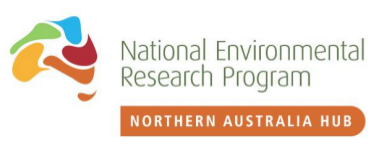
Bacterial survey of the S Alligator River Floodplain (Kakadu). The study was designed to examine how history to saltwater exposure alters microbial assemblages. The research was part of the NERP Northern Australian Hub. Data includes 90 samples taken from three different areas of energy (low, medium and high) and three areas of the floodplain (lower, upper and backwaters). The data includes processed 16S rDNA amplicons, GPS co-ordinates and soil chemistry.
-
The Australian National Algae Culture Collection (ANACC) is housed at the Hobart laboratories of CSIRO Marine and Atmospheric Research. The collection consists of 1000 strains of more than 300 microalgae species. The collection includes representatives from all classes of marine microalgae, some freshwater microalgae, and unusual marine microheterotrophs. The culture collection specialises in the Australian region, with microalgae from tropical to polar waters, as well as microalgae from around the world. Many Australian strains are genetically and biochemically different from those found elsewhere. Strains include: - nutritionally important microalgae for aquaculture feeds and human health - microalgal biodiversity for biotechnology - ecologically significant microalgae including bloom-forming and toxic strains for environmental management - reference cultures for pigment standards used in oceanography and water quality analyses. Housed in world-class microalgal culture facilities, the collection is a resource for investigations into the growth, physiology, taxonomy, biodiversity, chemistry and molecular genetics of microalgae. The facility specialises in: - isolation and culture of microalgae strains - bacteria-free culture techniques - growth optimisation and manipulation - biomass production - microalgal taxonomy - chemical and biochemical analytical capability - molecular and genetic techniques. The Collection Strain Database is accessible online (see data links).
-
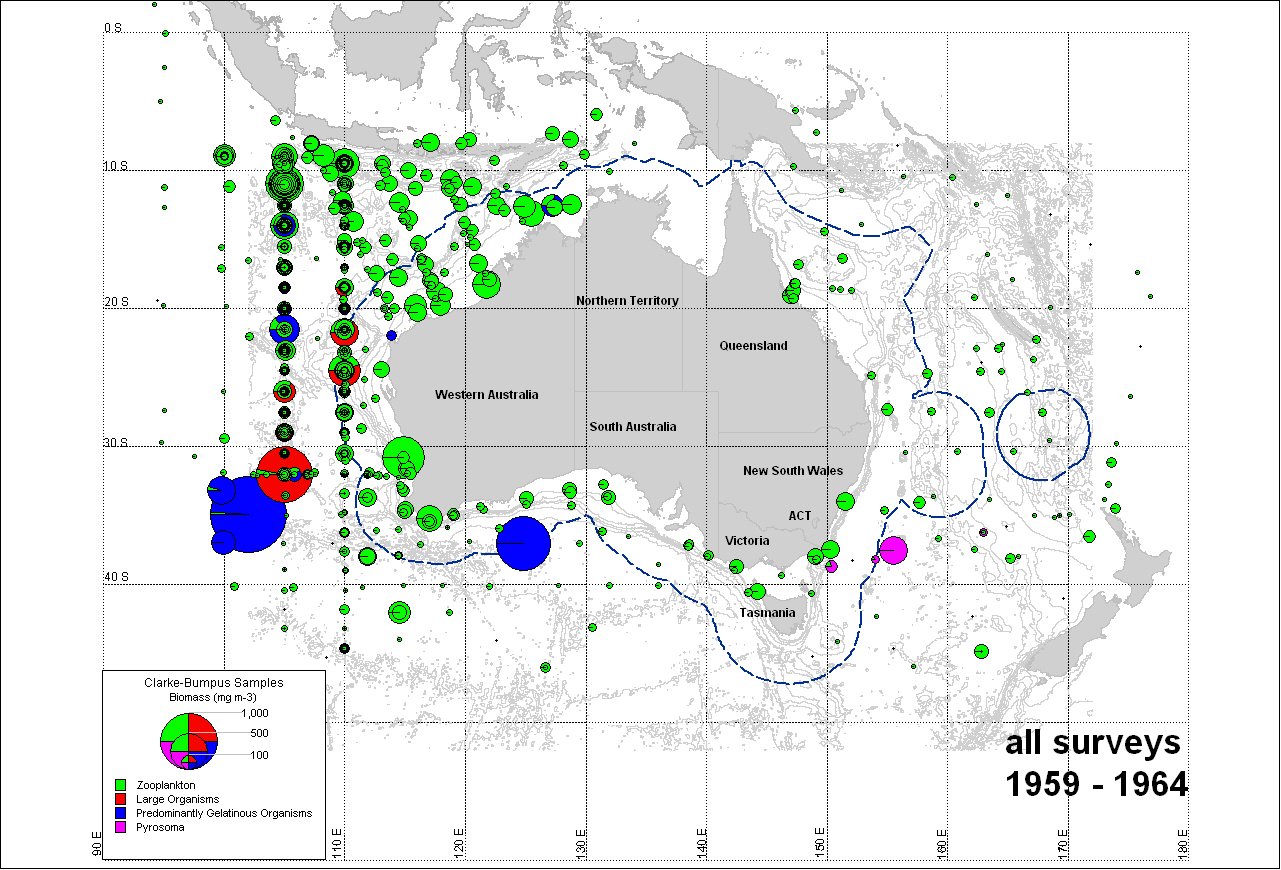
Map of zooplankton biomass in Australian waters. Data collected from oceanographic surveys conducted between 1959 and 1964 onboard the vessels "Gascoyne" and "Diamantina" using a Clarke-Bumpus Oblique Haul, with zooplankton biomass expressed in milligrams per cubic metre. These maps have been produced by CSIRO for the National Oceans Office, as part of an ongoing commitment to natural resource planning and management through the 'National Marine Bioregionalisation' project.
-
ESRI grids showing phytoplankton provinces around Australia. The information was supplied by Dr Gustaaf Hallegraeff, of the University of Tasmania in 2004 as an update of the Jeffrey/Hallegraeff 1991 phytoplankton map. Variations in onscreen colour representation or printed reproduction may affect perception of the contained data.
-
Zooplankton biomass point data that has been mapped using MapInfo along 110ºE, Indian Ocean using a standard net (samples from return-trips along the 110ºE latitude line were shifted to 105ºE). These MapInfo layers have been produced by CSIRO for the National Oceans Office, as part of an ongoing commitment to natural resource planning and management through the 'National Marine Bioregionalisation' project. Variations in onscreen colour representation or printed reproduction may affect perception of the contained data.
-
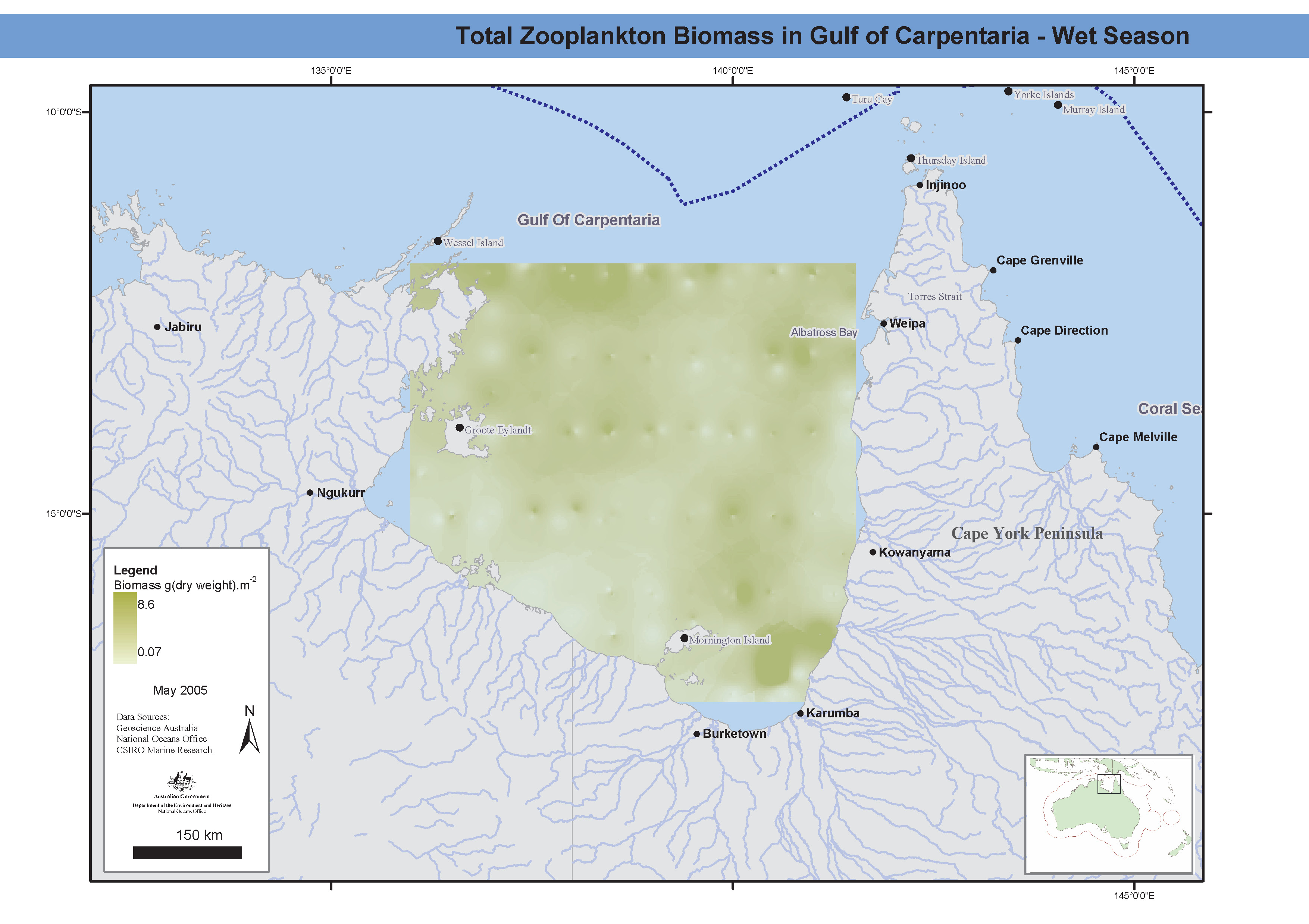
Maps of total zooplankton biomass (dry weight) from stepped oblique bottom to surface plankton tows from Albatross Bay. Biomass estimates from two mesh sizes. These maps have been produced by CSIRO for the National Oceans Office, as part of an ongoing commitment to natural resource planning and management through the 'National Marine Bioregionalisation' project.
-
Between March 1986 and April 1992, monthly cruises were carried out at 21 stations in Albatross Bay, Gulf of Carpentaria. Prawn larval densities were measured and salinity-temperature profiles taken. Prawn larval density from stepped oblique bottom to surface plankton tows. Net sizes were 142 or 140 m mesh, 250 micron mesh with a 0.5 x 0.5 metre square frame, stepped-oblique tow. In this dataset Penaid prawn counts were recorded to genus level for all larval stages.
-
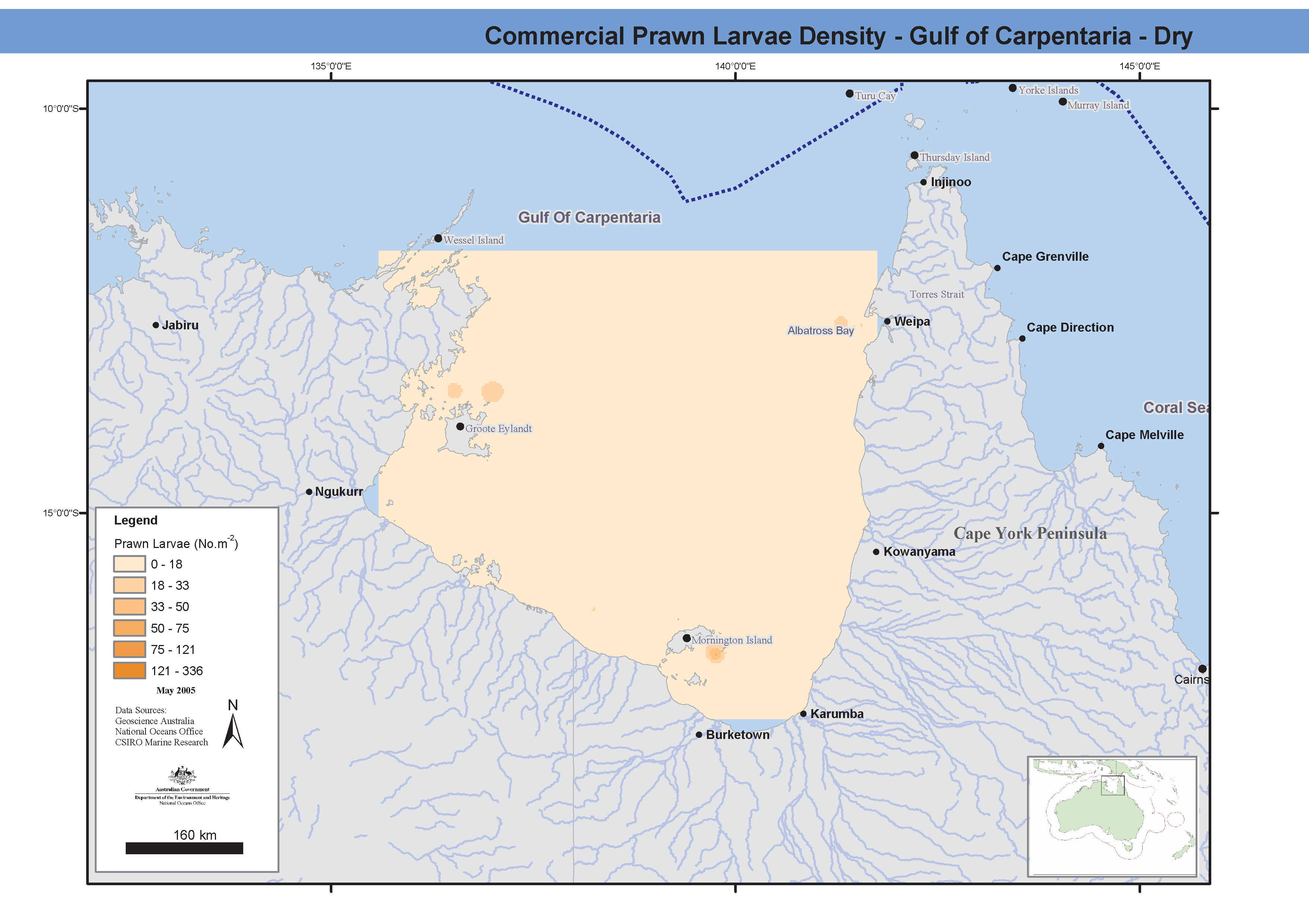
Maps showing prawn larval distribution of commercial prawn species during both the wet and dry seasons in Albatross Bay. The data was recorded from stepped oblique bottom to surface plankton tows, 140-142um nets. Nine cruises took place between 1975 and 1977 on chartered boats and the "Kalinda". Prawn larval biomass and densities were measured in several transects across the Gulf of Carpentaria, as well as total plankton biomass. These maps have been produced by CSIRO for the National Oceans Office, as part of an ongoing commitment to natural resource planning and management through the 'National Marine Bioregionalisation' project.
-
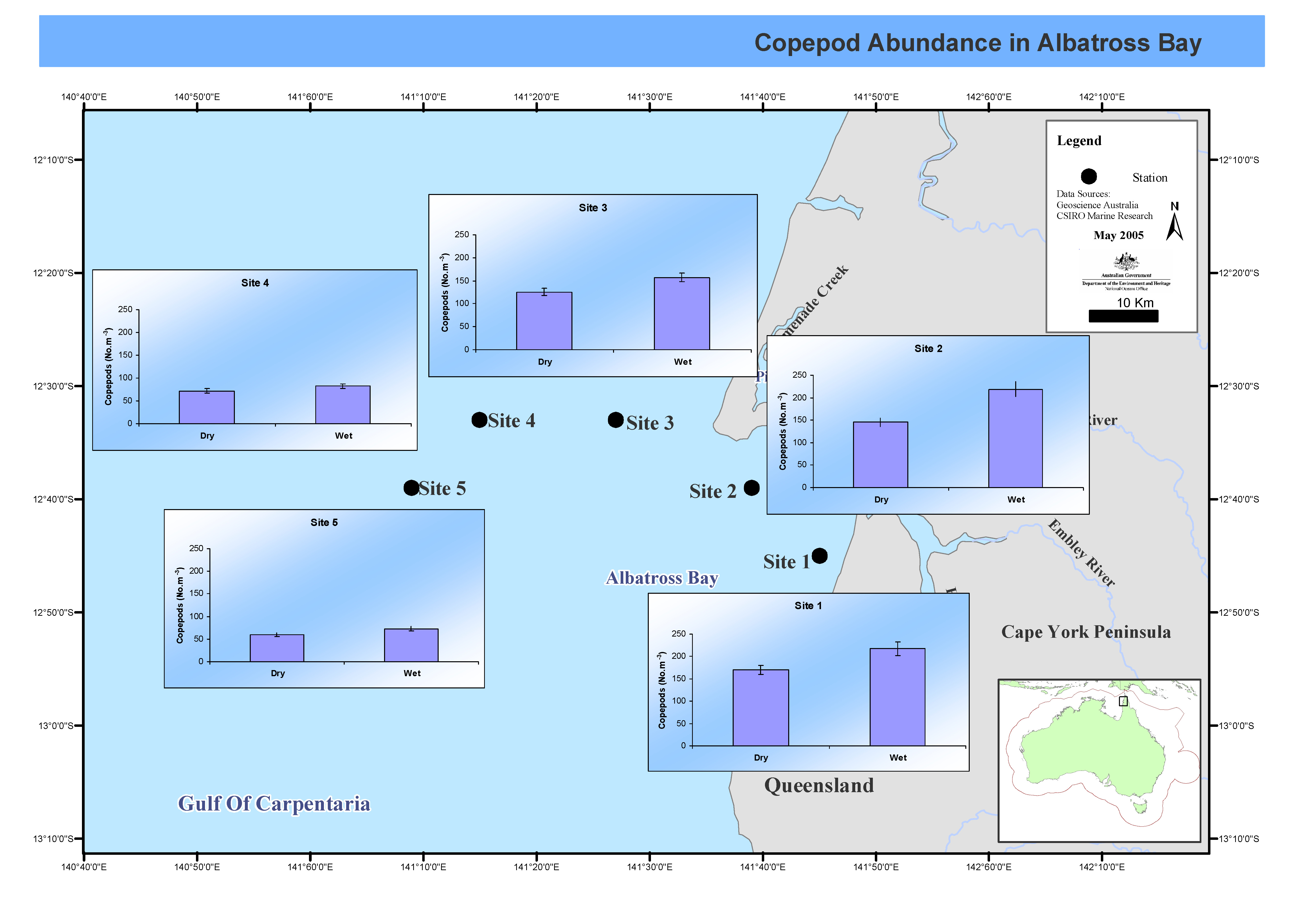
This map shows copepod abundance in Albatross Bay, Gulf of Carpentaria. The biomass and species composition of tropical zooplankton in Albatross Bay, Gulf of Carpentaria, northern Australia, were examined monthly for three years between March 1986 and March 1988. Zooplankton taxonomic groups were identified to species level where possible, with a primary focus on copepods. Data is stored as mean number of individuals per site. Sampling occurred across 5 sites (Site 1 = Inshore, Site 5 = Offshore, Sites progressed westward). Temperature and salinity were also recorded for many samples. This map has been produced by CSIRO for the National Oceans Office, as part of an ongoing commitment to natural resource planning and management through the 'National Marine Bioregionalisation' project.
